Pricing fiber art was a mystery to me for awhile. I priced randomly. I put value on it by how hard it was for me to create and at the time I was new to felting so everything was hard. But I also undervalued my work because I was scared of what people might say if I price it to high.
When I finally got my first pieces in a gallery shop, I asked the gallery director how artists price their work and she said it is always different for each artist but she'd recommend pricing at a base price.
Base price??
She said many painters price by square inch.
After she told me that, I really started thinking about how to properly price my work.
Using the base price model I created my own format for pricing my work.
Base price for a commissioned dog:
$300
This price reflects a dog that is 5-6 inches long.
For every two inches added in size it is an extra $50.
For any extras added such as a ball or dog bed the price will be reflected with these additions.
Base price for a commissioned bird:
$120
This price reflects a small songbird. 3 - 4 inches in length.
For every 2 inches added in size it is an extra $25.
For any additions such as a base the price will change to reflect this.
Now, how did I calculate that base price. I used the simple algorithm of time and material costs.
Something else to take into account when figuring out the base price is skill level and experience.
Hike that price up if you are more skilled and experienced. It may take you less time because of the knowledge you have and the price needs to reflect that instead of just the time it took.
When selling your needle felted creations it isn't often that it is just happening in person, without a hidden overhead cost. What kind of overhead cost am I talking about?
Welp, pretty much any online platform that you are selling on has an overhead cost. You should, 100%, take that into consideration when pricing your work. If to list a product it costs you $2 each time and when they purchase with a credit card, the credit card company takes a percentage, you should add that right back into the product to make up for the profit loss.
Also take into account shipping costs. If you have free shipping, calculate the actual shipping into the cost of the product.
Now if you are selling at a shop or it is a gallery piece remember most places take a commission of close to 30%. Your pricing should reflect this and a good shop will remind you and ask if it does.
Adding in the cost of material can be sort of difficult with needle felting because we use small bits of color here and there and a bunch of a few others but that doesn't mean we will actually use up a whole bundle of wool.
So here is an easy way to calculate it.:
Weigh your item.
On average a skein of wool is $3 -$4 per 2 ounces. If your piece is mostly wool you can just weigh it and see how many ounces it is and have an idea of the amount of material you used from that.
When it comes to your needles and felting surface, the things you use for all of your pieces, you shouldn't charge full price for that. Just add in a small fee to cover a percentage of it on each make.
Some of us are hobbyists. I am, in a way. I would needle felt even if I didn't make an income from it.
Some of us are hoping to make a business out of this. I will say with felting it is hard because it is so time consuming that you really never get that time completely paid.
But.... you should be paying yourself. Give yourself an honest hourly rate. Be your own manager and decide what you are worth, depending on your skill level.
I am guessing we have all experienced the negativity that comes with pricing. Money is always a tough subject with people and everyone has an opinion on what things are worth.
I don't know how many times I have heard "I could buy something like that at Walmart for much less".
That comment used to really goat me. I am better now. My skin has thickened.
The way I see it, is the people who say that are not the people I want buying my work.
We put our heart, soul, and blood into these needle felt creations. I want the people who buy from me to truly appreciate and understand the worth.
If someone is scoffing at the price most likely they are not going to care for my work properly and will not appreciate the time it took to make it.
At the end of the day, pricing your fiber art is about honoring both your craft and your creative journey. Your work is an expression of your soul, and it deserves to be priced in a way that reflects its uniqueness, your time, and your skill.
By weaving together the threads of cost, time, overhead, and market value, you can create a pricing strategy that celebrates both the magic you make and the world you share it with. So go ahead, price with confidence—your art is worth it.


